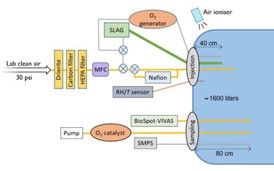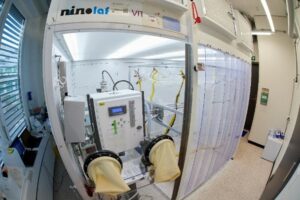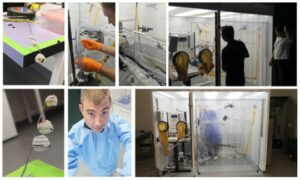SynAir-G partners at EPFL have developed a unique facility called the LAPI BREATH, a new biosafety level 2 aerosol chamber with the potential to revolutionize how we study the spread of respiratory diseases. Developed in close collaboration with the Swiss National Science Foundation SNSF and the IVEA and AirTRAC projects, the chamber aims to mimic the transmission of biosafety Level 2 viruses, such as influenza A and B, in realistic indoor air conditions. This allows researchers to analyze the impact of environmental conditions on virus transmission. As part of SynAir-G, the chamber offers a realistic testing environment for the real-time virus sensors developed by our partners at CNR, playing an important role in helping the project move forward.
The LAPI Bioaerosol Research & Environmental Airborne Transmission Hub (LAPI BREATH)
When a person infected with a respiratory virus coughs or sneezes, tiny aerosol particles carrying the virus are released into the air. These virus-containing particles are thought to be the vehicles for spreading viral respiratory diseases such as COVID-19 or the flu from one person to another, causing considerable human mortality. Despite their importance, it is still largely unknown how environmental factors interact with these airborne virus-containing particles and influence their infectivity. Understanding these links is essential for developing effective strategies to control the spread of aerosol-borne diseases indoors, reducing their transmission and protecting public health.
The LAPI Bioaerosol Research & Environmental Airborne Transmission Hub (LAPI BREATH) is designed to help bridge this knowledge gap. The facility nebulizes virus-infected lung (and other) fluids into a large chamber filled with indoor air, simulating how an infected person releases virus-containing aerosol particles when coughing or sneezing. These particles then interact with the indoor air environment, as they would in real life. The aerosol particles are then collected in a way that mimics a person inhaling them, allowing researchers to analyse their infectivity. Equipped with state-of-the-art instrumentation, LAPI BREATH recreates real-world airborne virus transmission scenarios while minimizing the inactivation of virus particles during collection, providing highly realistic data for research.


Figure 1: Schematic of the LAPI-BREATH facility (Motos et al.,2024). Figure 2: a fish-eye view of the facility in the laboratory
The facility allows researchers to study the behavior and infectivity of virus-containing aerosol particles once they are released into the air by an infected person. By varying the composition of the aerosolized medium (such as saline solutions, saliva, or lung fluid) and adjusting atmospheric conditions (humidity, temperature, and gas composition, including acids, organic compounds, or ammonia), researchers can evaluate how these factors affect virus infectivity. This approach helps identify environmental conditions that reduce virus infectivity, supporting the development of practical strategies to lower the risk of airborne virus transmission indoors.
There is no other facility in Europe currently that can study the behavior and response of airborne Biosafety Level 2 viruses to real atmospheric conditions. Researchers are therefore in a unique position to contribute to the development of groundbreaking indoor air treatment strategies that reduce viral transmission risks and can ultimately be applied in response to respiratory disease epidemics and pandemics.
How LAPI BREATH supports the SynAir-G project
The facility can not only be used to study the behavior of airborne virus particles in indoor air, but it also supports testing the performance of real-time virus sensors developed by SynAir-G partners at CNR. Recent tests using LAPI BREATH have shown that these sensors can successfully detect influenza A, influenza B, and SARS-CoV-2, bringing us closer to finalizing their development. Once deployed, these sensors will be revolutionary for monitoring virus levels and identifying virus types indoors.

Figure 2: Pictures showing the usage of the LAPI-BREATH facility to test a virus sensing device developed during the SynAir-G project.
Want to know more?
In the video linked here, Dr. Ghislain Motos (LAPI,EPFL) and Dr. Celine Terretaz (LAPI/LEV, EPFL) introduce the LAPI BREATH facility and explain how it is used to study airborne viruses.
To learn more about the chamber and how it has been used in investigations on airborne Influenza A virus particles, click here.
If you have any questions or would like more information about the facility, please don’t hesitate to contact SynAir-G or EPFL. We will continue sharing updates on the development of the virus sensors and the ways in which LAPI BREATH is advancing the project.
Stay connected! Follow Synair-G on Twitter and LinkedIn, and subscribe to the SynAir-G Newsletter to receive latest updates.
